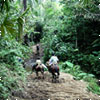
 |
Canopies, climate change and mammals |
Conservation Sciences is currently involved in a collaboration with Earthwatch on a project which aims to carry out innovative new research that will directly help the conservation of South American Cloudforest as well as develop tools that can be applied to the conservation of other ecosystems. The project provides an opportunity for students on the Ecology & Wildlife Conservation BSc to participate in this research by travelling to Ecuador and training as research assistants.
The project has been funded by Earthwatch, the charitable organisation which outlines its goals on their website. “Earthwatch is an international environmental charity which is committed to conserving the diversity and integrity of life on earth to meet the needs of current and future generations. Our mission is to engage people worldwide in scientific field research and education to promote the understanding and action necessary for a sustainable environment”.
The project itself has some key points of interest:
Project title: “SURVIVE – canopies, climate change and charismatic mammals”
The research question being addressed is “Are existing reserves and corridors sufficient to protect viable populations of larger ‘charismatic’ mammals in the long-term?”
The ‘charismatic’ mammals that form the focus of the project are the six carnivorous felines that inhabit forests in the region including the jaguar and puma , the spectacled bear and primates, including the brown-headed spider monkey (Ateles fusciceps) (considered one of the top 25 most endangered primates on the planet).
So why large charismatic mammals? Large mammals tend to have habitat requirements or ecological requirements that make them good ‘bioindicators’ of forest status due to heightened susceptibility to habitat destruction, fragmentation and hunting. They also act as ‘umbrella species’ that, if protected, ensure the conservation of countless other species of flora and fauna. For example, the brown-headed spider monkey is a frugivore (fruit eater) and so needs a large home range to ensure it can find enough fruit to sustain itself. Research has shown that it requires forest of at least 100 years of age, so is a very good indicator of high-quality primary habitat (Sorensen and Fedigan 2000). As it is a brachiator it deals poorly with forest fragmentation, so once again it reflects high-quality contiguous old growth forest. It comes as no great surprise that its distribution is now heavily restricted and is classified as critically endangered (Tirira 2001). Where it still exists, such as the Los Cedros Biological Reserve (Gavilanez-Endara 2006) and the Cotocachi-Cayapas Ecological Reserve, it is a key indicator of low hunting pressure and existence of primary forest habitat.
The primary research objectives of the first year of the Earthwatch SURVIVE project are to develop standardized field methods
Volunteers will work to help achieve the following:
For more information, please contact co-principle investigator Dr. Anita Diaz
19/07/07